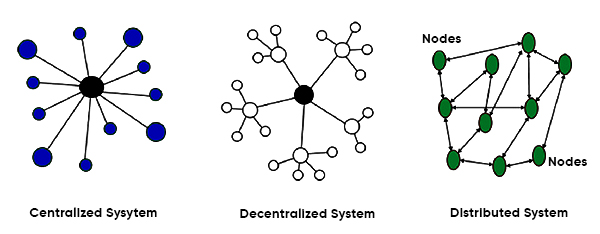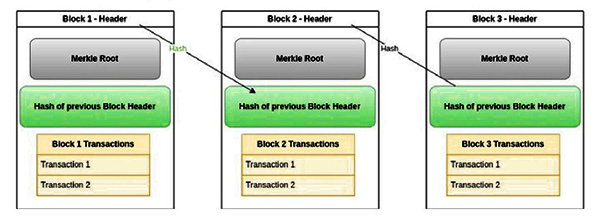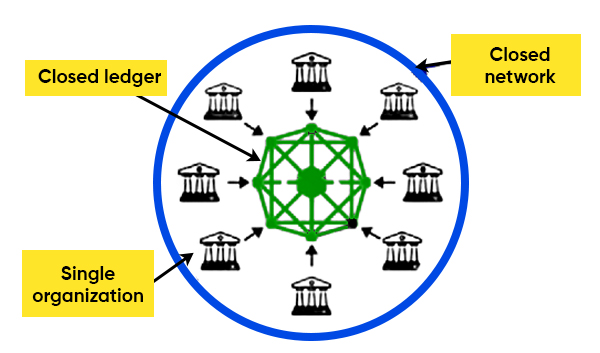
- Blockchain - Home
- Blockchain - Introduction
- History of Blockchain
- Blockchain - Technology
- Blockchain and Cryptography
- Blockchain Beyond Crypto
- Blockchain - Advanced Concepts
- Blockchain - Decentralization
- Blockchain - D-Apps
- Blockchain - DeFi
- Blockchain - Future Scope
- Smart Contracts in Blockchain
- Blockchain - Ricardian Contracts
- Blockchain - Oracles
- Blockchain - DAO
- Bitcoin
- Bitcoin - Invisible Gold
- How Bitcoin Works?
- Bitcoin - Network
- Bitcoin - Wallets
- Bitcoin - Innovations
- Ethereum
- Ethereum Alternate Cryptocurrency
- Ethereum Ecosystem
- Ethereum Virtual Machine
- Advanced Ethereum
- Ethereum Wallets
- Ethereum Miner Nodes
- Miscellaneous
- Blockchain - Double Spending
- Public Key Cryptography
- Blockchain - Hashing
- Bitcoin - Mining
- Blockchain - Chaining Blocks
- Blockchain - Proof of Work
- Blockchain - Network & Mining
- Blockchain - Incentives to Miners
- Blockchain - Merkle Tree
- Blockchain - Payment Verification
- Blockchain - Resolving Conflicts
- Blockchain - Privacy
- Bitcoin - Mitigating Attacks
- Blockchain - Conclusion
What is Blockchain Technology?
The emergence of blockchain technology has completely transformed the landscape of data exchange, transactions, and digital trust. Since its inception in 2008, blockchain has gained significant attention across various industries due to its key features such as security, transparency, and decentralization.
Blockchain serves as a distributed ledger, securely storing data across a network of computers. This sets it apart from centralized systems, where information is stored in a single location controlled by a central authority. Operating on a decentralized network, blockchain enables every participant to have a copy of the entire ledger, eliminating the need for intermediaries and fostering digital trust among users.
While blockchain initially gained recognition as the foundation for Bitcoin, its applications extend far beyond cryptocurrencies. It has found uses in sectors such as healthcare, real estate, finance, supply chain management, and more. This chapter seeks to offer a comprehensive overview of blockchain technology and its potential to bring about transformative changes.
Rise of Blockchain Technology
One of the significant transformative technologies of the 21st century is blockchain. Blockchain is a technology that is poised to usher in a new way of conducting business that will change everyday life for the better. Blockchains are virtual, and therefore, they have no physical form.

The image above depicts a series of blocks, each containing data in the form of a distributed ledger. This serves as a database that can be shared among multiple devices or institutions, allowing for the sharing of information rather than copying or transferring it. The blocks within the ledger are organized in chronological order.
Blockchain is an ever-growing digital database that consists of a linked list of records. It contains sensitive information, such as financial transactions, which are safeguarded by cryptography and can be shared across a large, decentralized, and publicly accessible network. Each block in the chain includes a cryptographic hash of the previous block, a timestamp, and transaction data. This technology has emerged as a potential solution to the problem of declining trust in traditional institutions and online intermediaries, as it purportedly eliminates the need for trust between parties.
What is a Blockchain?
A blockchain functions as a decentralized and distributed ledger that securely records transactions across multiple computers, preventing retroactive alterations. This technology is widely utilized in finance, supply chain management, and various other industries due to its ability to provide transparent and secure record-keeping.
In essence, a blockchain serves as a digital ledger for tracking transactions and data, akin to a personal notebook for recording daily expenses. This ledger is accessible to many individuals, allowing for visibility and contributions from all participants, similar to a shared notebook among friends. Transactions are permanently recorded in the ledger, with very blockchain participant possessing a copy, ensuring the integrity of past transactions.
The absence of a central authority, like a bank, eliminates the need for centralized transaction monitoring, enhancing security, transparency, and fairness within the system. Essentially, a blockchain acts as a digital ledger for securely tracking transactions and data, shared among a network of participants, resembling a communal bulletin board for posting messages and monitoring contributions.
Centralized Vs. Decentralized Vs. Distributed Architecture

| Centralized System | Decentralized System | Distributed System |
|---|---|---|
| All data and processing power is stored and managed by a single central authority. | The system is spread across multiple nodes, but there is still a central authority that manages and makes decisions for the system as a whole. | The system is spread across multiple nodes and there is no central authority controlling the system. |
| There is a single point of control, and communication is centralized through a central node. | Multiple nodes communicate with each other, but the central authority remains in control. | Each node communicates with other nodes and collaborates to make decisions for the system as a whole. |
| Centralized networks are typically the most costeffective options for small systems and require fewer resources to set up and maintain. | Decentralized networks improve user request speed by establishing local master nodes in high traffic areas, rather than routing to a central server. | Distributed networks offer robustness with node failure as computational workload is rebalanced among remaining nodes. They are more robust than other network architectures. |
| Easier to standardized interactions between the main server and client nodes. That can lead to a more consistent and streamlined end user experience. | Since decentralized networks do not have a single point of failure, they can continue to operate even if a master node is compromised or shut down. | Distributed networks are more scalable than both centralized and decentralized networks. They generally exhibit lower latency as well due to the even distribution of network processing power and data. |
| Centralized networks are characterized by well-defined command structures, which facilitate easy delegation and minimize communication overlap across different authorization levels. The process of adding or removing client nodes is also uncomplicated. | Decentralized networks speed up user requests by having local master nodes in high traffic areas, instead of routing to a central server over large distances. | In a distributed network, data is evenly shared and harder to modify, censor, or destroy, making the network more transparent. This is often further secured through cryptography. |
Simplified Architecture of Blockchain
Blockchain represents a decentralized and distributed ledger that encompasses various transaction types organized within a peer-to-peer network. This network comprises numerous computers, each contributing to the collective agreement necessary to prevent unauthorized modifications of data.
The architecture of blockchain technology is characterized by a sequence of blocks, each housing a collection of transactions arranged in a specific order. These blocks may be maintained as a flat file or within a straightforward database. Two fundamental data structures employed in blockchain technology are pointers and linked lists, which are crucial for maintaining the integrity and immutability of the data within the blockchain network.

A concise overview of pointers and linked lists is as follows −
- Pointers are variables that hold information about the location of another variable, effectively indicating its position.
- Linked lists consist of a series of blocks arranged in a defined order, with each block containing particular data and linked to the subsequent block via a pointer
Key Characteristics of Blockchain Architecture
The blockchain architecture provides various advantages to businesses. Some of its primary features include −
- Cryptography − Blockchain transactions are verified and reliable thanks to the intricate calculations and cryptographic evidence among the parties involved.
- Immutability − Any data stored in a blockchain cannot be altered or removed.
- Provenance − This refers to the ability to trace the origin of every transaction within the blockchain ledger.
- Decentralization − Every member of the blockchain framework has access to the entire distributed database. Unlike a centralized system, the consensus algorithm enables network control.
- Anonymity − Each participant in the blockchain network has a unique address, rather than a user identity, ensuring user anonymity, particularly in a public blockchain structure.
- Transparency − The blockchain system is highly resistant to corruption, as it would require significant computing power to completely overwrite the blockchain network.
Key Factors of a Blockchain Networks
Various essential factors that influence the working of blockchain architecture include −
- Distributed structure − The distributed nature of a blockchain network is a key characteristic. It eliminates the necessity for a central authority and enables multiple nodes to engage in the network and verify transactions.
- Blocks − A block is a data unit that comprises a group of transactions, a timestamp, and a reference to the previous block, also referred to as a hash. This forms a chain of blocks, hence the term blockchain.
- Nodes − Nodes are the computers or devices that take part in the blockchain network. Each node retains a copy of the entire blockchain and aids in validating transactions and generating new blocks.
- Consensus mechanism − To ensure data integrity, the network employs a consensus mechanism. This enables nodes to agree on transaction validity and helps prevent unauthorized modifications to the blockchain by malicious actors.
- Public/private keys − Public and private keys are utilized to create a digital signature for each transaction. The public key encrypts the data, while the private key decrypts it.
- Hashes − A hash is a crucial element of blockchain technology, serving as the foundation of its secure architecture. Essentially, a hash is a unique representation of data generated through a cryptographic hash function. It functions as a digital fingerprint for each block in the blockchain, offering a secure and immutable means to identify and trace the block.
- Chain of blocks − The hash of a block is connected to the hash of the preceding block, forming a chain of blocks that establishes the core of a blockchains architecture.
- Proof-of-work − This mechanism makes it challenging for anyone to alter the information stored in a blockchain. It entails a computational work process that must be executed to append a new block to the chain, rendering it time-consuming and resource-intensive.
- Block formation of transactions − Within a blockchain network, transactions are compiled into blocks. Each block is characterized by a timestamp, a reference to the preceding block (commonly referred to as a hash), and a collection of transactions. This structure results in a sequential chain of blocks, which is the essence of blockchain technology.
- Node verification − The nodes within a blockchain network play a pivotal role in validating transactions and incorporating new blocks into the blockchain. For instance, when a user intends to transfer funds to another individual, the transaction must undergo verification by the network's nodes prior to its inclusion in the blockchain.
- Role of cryptography − Cryptography serves as a fundamental component of blockchain architecture, ensuring the security of the data contained within the blockchain. Each block and transaction is subject to encryption, and a digital signature is employed to confirm its authenticity. Public and private keys facilitate the creation of a digital signature for each transaction, with the public key utilized for data encryption and the private key for decryption.
- Crypto tokens − These digital assets are tradable on a blockchain and are frequently employed to motivate nodes to validate new blocks.
- Smart contracts − A significant feature of blockchain architecture is the implementation of smart contracts. These self-executing contracts automatically enforce the terms of an agreement when specific conditions are satisfied. This functionality removes the necessity for intermediaries, thereby enhancing the efficiency and transparency of the blockchain network. For example, a smart contract can facilitate the automatic transfer of funds from one user to another upon the fulfillment of a predetermined condition, such as the successful completion of a project.
Types of Blockchain Networks
There are mainly three types of blockchain networks that have evolved from conventional and traditional network based system based on decentralization. These networks are as follows −
- Private Blockchain
- Consortium Blockchain
- Hybrid Blockchain
1. Private Blockchain
A private blockchain is a specific type of blockchain technology that is limited to a particular group of participants and is commonly utilized by organizations and institutions for internal operations. It operates as a permissioned blockchain, meaning it is controlled by a single entity. Unlike public blockchains, private blockchains are not open-source, and only authorized individuals can access the network. This allows for effective blockchain usage while restricting access to selected participants.
Organizations can establish various parameters for the network, such as accessibility, authorization, and more. Transactions on private blockchains are typically faster and more secure, although they lack the transparency and decentralization of public blockchains. Private blockchains are more scalable when compared to other factors. Permissioned blockchains do not adhere to a decentralized theoretical nature.

Some blockchain platforms are built on private blockchains, and while many consider private blockchains as permissioned blockchains, the concept of permissioned blockchains can encompass public blockchains as well. Due to the limited number of nodes in private blockchains, security may be compromised if a certain number of nodes become malicious and disrupt the consensus mechanism of the network.
2. Consortium Blockchains
Consortium blockchains represent a blend of public and private blockchain characteristics, aimed at harnessing the advantages of both systems.
Also referred to as federated blockchains, consortium blockchains offer an innovative solution for organizations that require features from both public and private blockchains. In this model, certain elements of the organizations are accessible to the public, while others are kept confidential. The governance of consortium blockchains is shared among a collective of organizations, rather than being dominated by a single entity or a small group of individuals. These blockchains are particularly prevalent in sectors such as finance, where participating organizations seek a secure and transparent network while retaining a degree of control over its operations.

To ensure effective functioning, a consortium blockchain typically incorporates a validator node tasked with two primary responsibilities: validating transactions and either initiating or receiving them. In contrast, member nodes within the network are restricted to either initiating or receiving transactions. This structure allows consortium blockchains to provide the advantages of a private blockchain, such as transparency, privacy, and efficiency, without allowing any single participant to wield excessive power or control over the network. By distributing authority and accountability among multiple entities, consortium blockchains achieve an optimal balance of security, flexibility, and accessibility, making them suitable for a variety of applications and use cases.
3. Hybrid Blockchain
Hybrid blockchain is the final type of blockchain that will be discussed in this context. Hybrid blockchain may appear similar to a consortium blockchain, but it is distinct. Nevertheless, there are potential similarities between the two. A hybrid blockchain is characterized as a fusion of a private and public blockchain. This particular blockchain type enables organizations to capitalize on the advantages of both private and public blockchains, providing an optimal solution for their specific requirements.
Operating within a closed ecosystem, a hybrid blockchain grants organizations the necessary control and privacy, while still enabling interaction with a public network. An illustration of a hybrid blockchain includes Dragonchain and XinFin, which present a distinctive solution for organizations seeking a blend of benefits. Through the integration of the privacy and control of a private blockchain with the transparency and accessibility of a public blockchain, organizations can enhance their operations in terms of efficiency and security.
Blockchain Vs. DLT
DLT and blockchain are frequently used interchangeably, but they are not exactly the same. While both are designed to address the same issue of securely and efficiently sharing information and data among multiple parties, DLT is a broader term that encompasses other technologies, whereas blockchain is a specific type of DLT.
Although both are related, they have distinct differences that set them apart. Here is a comparison between DLT and blockchain −
Blockchain
- Blockchain is a type of DLT that establishes an open and transparent ledger of transactions.
- It utilizes a series of blocks linked together with cryptography to form a growing list of records, known as blocks.
- Each block has a unique hash, a timestamp, and transaction information.
- This creates a secure and transparent ledger of transactions that is maintained by a network of nodes and is difficult to alter.
DLT
- DLT is a digital system that shares information and data across a network of nodes.
- It is a term that encompasses various technologies, including blockchain, that enable secure and efficient data sharing among multiple parties.
- DLT is commonly used for financial transactions and utilizes cryptography to maintain the security of the information on the ledger.